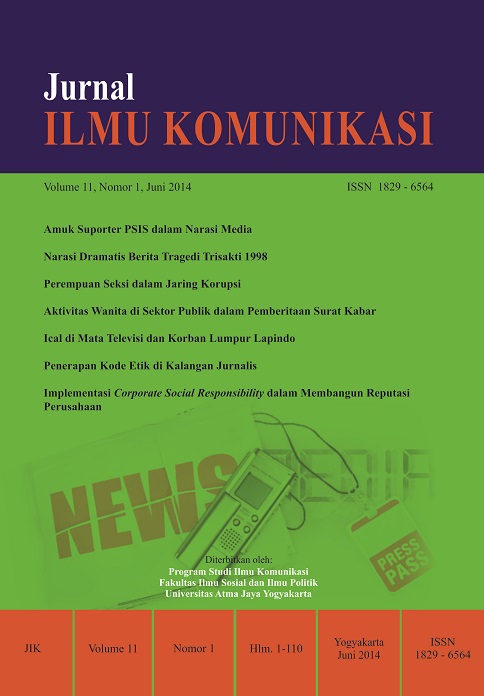Narasi Dramatis Berita Tragedi Trisakti 1998
DOI:
https://doi.org/10.24002/jik.v11i1.382Abstract
Abstract: Reviewing a news text narrative has strategic value due to mass media role to construct an empirical understanding and lead to collective memory reproduction of the reality constructed. This study analyzes the dramatic aspects related to human rights issues in the Trisakti tragedy of 1998 in the GATRA magazine using Seymour Chatman’s structural narative. The result shows that the dramatic intention is formed through the composition of story (plot, contingency, anachronistic narrative sequence, sequence repetition, omission events) and discourse (detail, coherence, active-passive sentence, lexicon, metaphor). News containing drama could create incomplete understanding of the reported reality.
Â
Abstrak: Meninjau-ulang narasi teks berita mempuyai nilai strategis karena media massa memiliki peran mengonstruksi pemahaman masyarakat atas realitas empirik peristiwa yang diberitakan dan mengarahkan reproduksi memori kolektif realitas bentukannya. Studi ini menganalisis aspek dramatis berita terkait masalah HAM dalam peristiwa Trisakti 1998 di majalah GATRA dengan menggunakan naratologi struktural Seymour Chatman. Hasil kajian menunjukkan bahwa intensi dramatik dibentuk melalui susunan story (plot, kontingensi, urutan cerita anakronis, repetisi sekuen, penghilangan peristiwa) dan discourse (detil, koherensi, kalimat pasif-aktif, leksikon, metafora). Drama dalam pemberitaan dapat menciptakan ketidakutuhan pemahaman atas realitas acuan yang diberitakan.
Downloads
Published
How to Cite
Issue
Section
License
Jurnal ILMU KOMUNIKASI is an academic journal. As such, it is dedicated to the open exchange of information. For this reason, JIK is freely available to individuals and institutions. Authors who publish in Jurnal ILMU KOMUNIKASI will release their articles under the Creative Commons Attribution (BY) License. This license allows anyone to copy and redistribute the article in any medium or format as well as remix, transform, and build upon the material for any purpose, even commercially as long as they credit the authors for the original creation. For details of the rights authors grants users of their work, see the "human-readable summary" of the license, with a link to the full license. (Note that "you" refers to a user, not an author, in the summary)
 This work is licensed under a Creative Commons Attribution 4.0 International License.
This work is licensed under a Creative Commons Attribution 4.0 International License.














